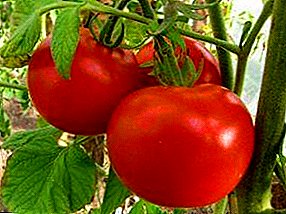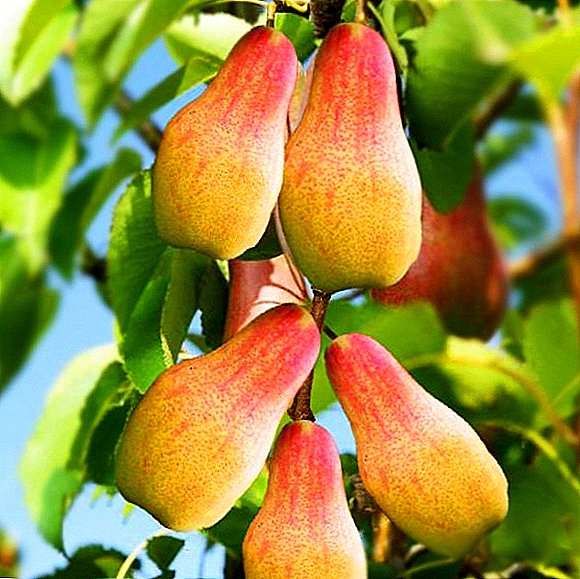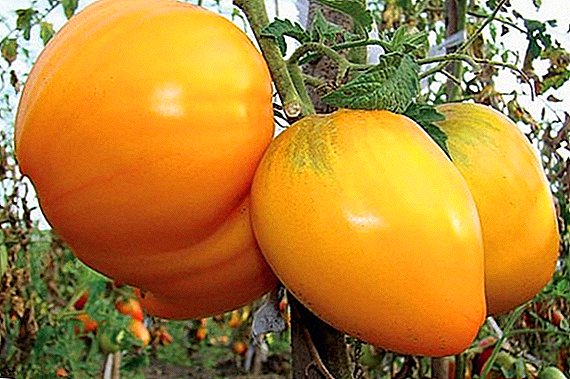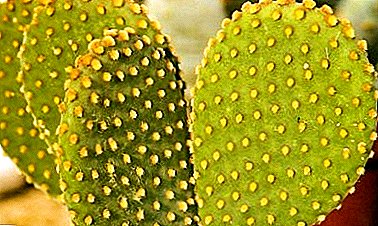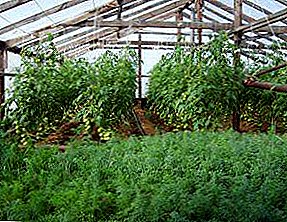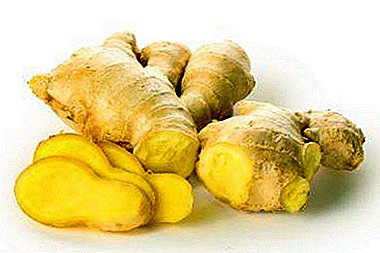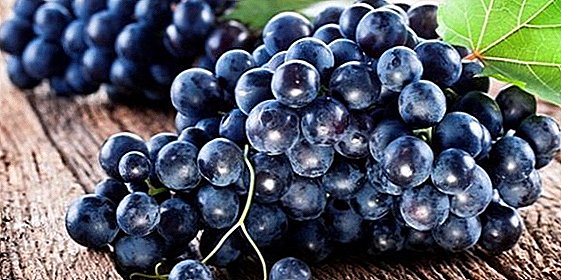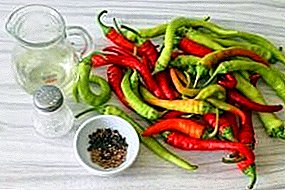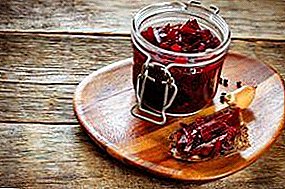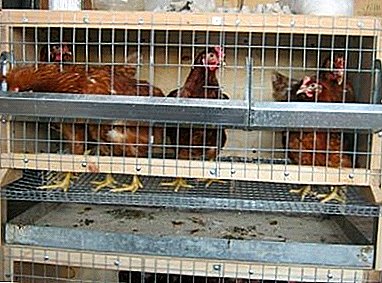
There are only two ways to keep laying hens: intensive and walking. With intensive keeping, birds can be kept either on a deep litter or on cellular batteries.
Both methods have their advantages and disadvantages, in this article we will focus on the cellular content of the layers. And about the organization of walking for chickens, you can read here.
Features of the cellular content
 With this method, the content of chickens is usually placed in small groups, 5 or 6 individuals in one cage.
With this method, the content of chickens is usually placed in small groups, 5 or 6 individuals in one cage.
However, each individual should have at least 0.1 square meters. m square of the cell, otherwise the chickens will be too crowded and their quality of life will deteriorate significantly.
In case the hens are kept individually, then 0.5 square meters is enough. m area for one individual.
Immediately it should be noted that the cellular content seriously limits the movement of layers. They can not lead an active lifestyle, walking around the yard, so they need special care.
It is advisable to constantly maintain the same microclimate in the hen houseso that at different times of the year livestock feels good. Details about the proper organization of the content of laying hens you can read here.
Unfortunately, only with the help of such a method it is possible to place the bird as compactly as possible on the territory of one chicken farm, therefore the cage content is common among large farms.
In order to minimize unpleasant consequences for chickens, we recommend choosing only those breeds that most easily tolerate such content.
How to arrange accommodation of laying hens correctly?
The cages where the birds will be kept are made of five-tier columns of three- or five-tier batteries made of wooden materials or metal. The floor with this content is made of metal rods. A small gutter is formed on it from the outer part of the cage, and the floor itself is placed under a slight bias. In the groove will get eggs collected from the cells.
In the photo below you can see how the cells for chickens look like, which can be made up in several tiers:



Trays are set to collect litter under the floor.which are easily retractable for cleaning. In non-mechanized cells on the front of the door in front of the door there is a water bowl and a trough. As a rule, one drinker is installed in two adjacent cells. Most often it is fully mechanized, as well as feeders for layers.
Proper organization of the content of chickens includes many important points and this applies not only to the cells.
In winter, the heating of the house with cages is necessarily organized. In winter, the temperature should be maintained at 16 degrees, and in summer - at 18 degrees.
To cope with this task you will need information about the construction of the chicken coop and the actions involved.
Lighting
 Due to the lack of free range, the hens are forced to receive light from artificial sources.
Due to the lack of free range, the hens are forced to receive light from artificial sources.
The fact is that illumination favorably affects not only the health of the hens, but also the egg productivity.
It is especially important to establish the correct lighting in the hen house during the cold period of the year, when, by their nature, birds cease to fly.
In the room where there are cages with birds there should always be uniform lighting. In no case should not allow the formation of too dark and too light corners.
Gradually turning on the light is necessary to reduce the stress of birds. In addition, the illusion of changing the time of day is created, so the birds perceive such lighting as completely natural.
Often, a different color spectrum is used to improve the egg production of poultry in large poultry farms.. The owners of the poultry farms constantly alternate the range of red, orange and yellow colors, which favorably affect the egg productivity of the birds, the chickens become calmer, which immediately affects their health.
Feeding
In terms of the cellular content of laying hens should receive a well-balanced feed, as they do not go out for walking. Most often layers in factory conditions are fed with mixed feed. It begins to be given from the beginning of puberty to the end of the egg-laying.
For feeding layers living in cages, crumbly feed is ideal. Birds will collect food for a long time, spending most of the day doing this. For birds restricted in movement, this method of feeding will have to be just the way, since they will spend some amount of energy during intensive pecking of food.
The composition of crumbly feed must include wheat grains, calcium carbonate, sunflower meal, any vegetable fats, salt and vitamins. In no case should not use food with the addition of drugs and dyes, since the body of the hen can not cope with the digestion of such food.
It is believed that the best feed for chickens should contain 15% protein, 5% fat, 6% fiber and a small amount of useful minerals and vitamins.
The most detailed information about feeding is collected in the appropriate section of the site.
Feeding laying hens contained in cellular batteries takes place with the help of automatic feeders. Food gets into special gutters in cages where chickens quickly peck at it.
As the feeder looks like you can see in the diagram and the photo below:



At the same time, birds should have free access to water. On average, each layer should drink at least 500 ml of water per day, so you need to worry in advance about the arrangement of drinking bowls.
Most often in the territory of the chicken farm is used the chute drinker. It consists of a gutter through which water flows, fixings, a valve tap and a nozzle for draining. These automatic drinkers are very convenient to use, since their installation requires a small length of pipes. But they need to be washed periodically, as the drain pipes often become clogged and fail.
Often used and drinkers nipple type. Examples you can see in the photo below:



What are needed feeding in the diet?
All laying hens living in cages should be fed in the form of vegetables, herbs and fruits. The fact is that the birds never go out for walking, so their body may feel a lack of certain vitamins, which can lead to eating disorders.
In the feed for laying hens, mowed and chopped lawn grass, kitchen waste, skins of fresh vegetables and weeds are added. However, the real delicacy for laying hens is cabbage of various kinds, pumpkin, apples and green salads. All these ingredients need to chop finely and add to birds in the feeder.
Usually the hens primarily choose green fodder, and then proceed to eat cereals.
Remember that unbalanced diet leads to a lack of vitamins, and this in turn has a variety of consequences.
Cleaning cells and house
 Proper maintenance of laying hens depends on how well the cleanliness of their habitat is maintained. To do this, follow the sanitary and hygienic standards of poultry. Cleaning in the house should be regular, especially when it comes to the cage content of the hens.
Proper maintenance of laying hens depends on how well the cleanliness of their habitat is maintained. To do this, follow the sanitary and hygienic standards of poultry. Cleaning in the house should be regular, especially when it comes to the cage content of the hens.
To keep the cell clean you need to wipe her twigs daily. Trough after feeding the grain thoroughly washed. If chickens are fed with green fodder or wet mashes, the feeders are cleaned immediately after the end of the chicken meal.
As for the litter, it falls on special pallets placed under the cages. They are cleaned with special scrapers as they are filled. After this, the litter is sent to the workshop for processing, where it becomes a good fertilizer for plants.
In detail about disinfection and hygiene, as well as how and from what the litter is organized in chicken coops you can read in separate articles.
Prevention of parasites and diseases
With the cellular content of laying hens, the risk of viral and fungal diseases increases significantly. That is why preventive vaccinations are constantly carried out on poultry farms. This is especially true of young laying hens, who are considered to be more susceptible to various diseases.
To get rid of possible feather parasites in cages with chickens ash baths are installed. They are small wooden boxes, which are almost filled to the top with ash, sand and dust. By taking such baths, the chicken kills all the louse and ticks that infest its plumage, reducing the quality of life in the hen house.
Conclusion
The cellular content of laying hens is often more profitable than the maintenance of chickens in other conditions. Cages with poultry occupy a much smaller area, so many more chickens can be placed on the territory of the chicken farm.


